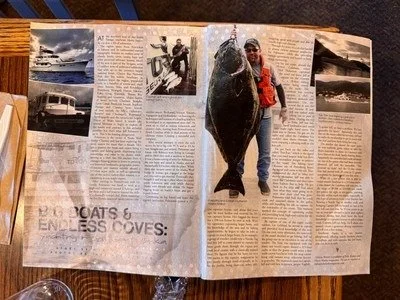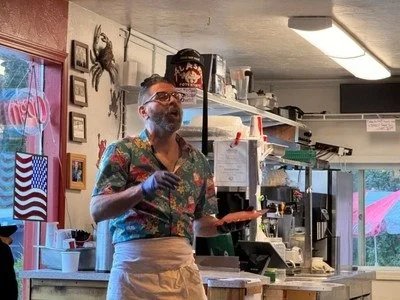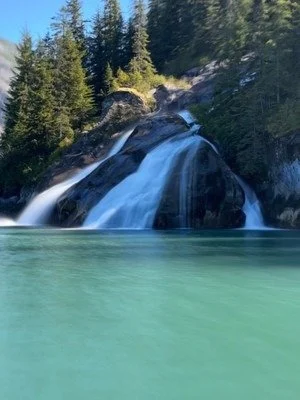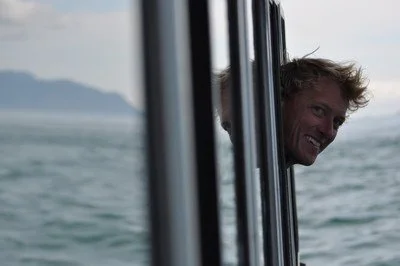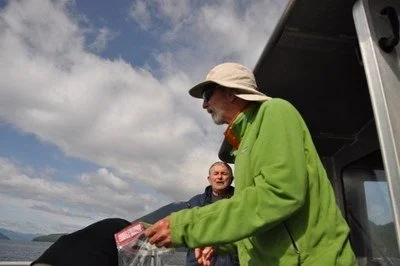Chapter 13: Bubble Net Feeding Explained
Pace, Kelley along with Josh and Andrew host the rest of us on an admittedly slow and long day
Each morning at 7:00 our group convenes at Hot Bite Restaurant at Auke Bay Harbor. Owner/chef/maitre'd/bon vivant/entrepreneur Jeff Polizzotto feats us. He’s a renaissance man of the highest caliber. An orphan adopted by a Sicilian couple at the age of one month, he grew up to become a high-end restaurant sous chef. Then, he shifted gears to become an entrepreneur and at 33, he sold his tech startup (VC3) and retired. But didn't relax.
Since then he has become a lodge owner and experienced (and licensed) 50-ton yacht captain. But, for us, he’s our breakfast cook—and master of ceremonies for an hour each day.
Off the pier a bit after 8:00, we are into Tracy Arm just before 11:00. The ride was bumpy. As it flattened, Josh had Andrew get a spray bottle of fresh water to squeegee the front windows. Back under way, Josh’s comment was, “You guys will have to watch for wildlife, bears and mountain goats. I’ve got to watch for ice.” As we got closer to the glacier, the bergs, none of them really large, became more plentiful. Our first actual stop was for one of the many waterfalls—this one named “Icy Falls”—along the edges of the fjord, more usually in Alaska called ‘arms’. For me, this beats Norway.
We made our way toward South Sawyers Glacier but encountered more ice than RipTide should handle. So around noon, we reversed course and made our way up another arm toward Sawyers Glacier. Sawyers offers a lot of blue ice which is formed (like B4’s lab grown diamonds perhaps) under greater pressure. These pieces of ice are not bergs; instead they are called “growlers” or, if even smaller, “bergy-bits.”
Mark offers up a quote from naturalist John Muir who visited this spot over a century ago. It’s “a wild and unfinished Yosemite.” He went on, “no ice work I have ever seen surpasses this, either in the magnitude of the features or effectiveness of composition.” When he was here, there was five miles or more of glacier which has, by now, melted away.
We looked for mountain goats but they have, we’re told, mostly moved on—we are here too late in the season. There were no bears to be seen either. We did see staghorn sculpin and crescent gunnel—water birds. Several had meals in their beaks.
After much motoring—much—we encounter sea lions on our way to Dawes Glacier where there is a minor calving event poorly captured on video by yours truly.
Then, it was nearly three hours to home.
Since there isn’t really much to report about today, I will take the opportunity to answer questions from yesterday and the day before.
Bubble net feeding.
Think of it as a whale seder (the fifteen step Passover meal that brings an entire Jewish family together). These magnificent creatures, without a homeland of their own, always moving, escaping persecution from whalers who very nearly removed them as an entire species from the earth celebrate like a family sustaining themselves for fasting yet to come.
Ok, so it happens multiple times a day and not just at sundown (sundown in the summer in Juneau doesn't happen until after nine o'clock this time of year). And there is no wine. But these whales are coming out of hiding, they are passing through what to us is bitter salty water and they are in a Haggadah of a sort in that they commune in a highly choreographed procedure that they seem to highly enjoy, celebrating their own thousands-of-years-long perpetual exodus.
Bubble net feeding, for my eyes this week, involves a large group of whales--sixteen to eighteen by our count--working in tandem in a precisely choreographed fashion.. One of them leads. It provides an auditory signal (Andrew and Josh repeatedly warned us of an impending event by listening to a hydrophone draped over the side of Riptide) from deep below a school of, in this case, herring. The group then forms up, circles, and releases air from their blow holes which creates a gigantic mass of rising bubbles. That cylinder of rising air confuses the herring who are surrounded by this wall of virtual carbonation. For what they must think is safety and as a result of being trapped, they cluster together. The humpbacks open their massive jaws and rocket upward, scooping up as many herring as they can. Captain Josh and first mate Andrew discussing this with Whale Trust excursion participant Greyson surprised me by estimating that each whale only captures twenty or so fish in each event--I would have thought more.
The event, repeated over and over and over, shows high biological intelligence and a sense of teamwork. The behavior is, I am told, not instinctual. It is learned.
For half the year in these colder waters, the whales feed, preparing for fasting for the remainder of the year. For almost the entire day--estimates are for twenty-two hours at a stretch, if they locate the right prey, they bubble net feed consuming up to 3,000 pounds of food a day. From the photographs you have seen here, note that these whales have from one to three dozen grooves running from their chines to their navels. (That's right: navels. These are mammals.) The grooves allow the mouths to expand--like unfolding pleats in a skirt or accordion. They swallow the gulp of water containing their meal and it is expelled through their "baleen" while they ingest only the fish. Baleen is the fringe-like filter made up of material not unlike our human fingernails. Interestingly, the fish are their hydration source.
I am, as you can see, both fascinated and thrilled to witness this mayhem and, if only marginally, understand it.
Who is on this trip? Peter and Nancy from San Francisco (he a retired Apple guy and she a retired high-pressure nurse dealing with complicated transplant type issues), Maria and Greyson (she his mom and a retired National Geographic photo editor and he a high school junior), Ann (a Pittsburgh retiree and accomplished world traveler) and her friend Thua (an avid iPhone photographer and prospective world traveler), along with yours truly, enjoyed this day even though it was mostly consumed with opening up our two 350 horse Mercury outboards to full throttle in search of some things we did not find and others we did.
Grayson shot--and shared--this beaver video!
